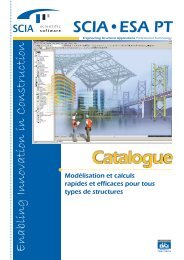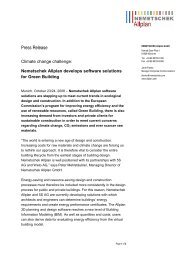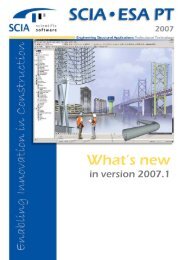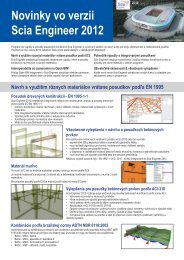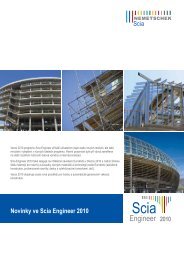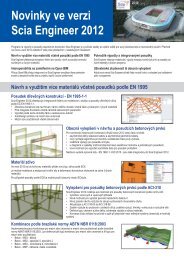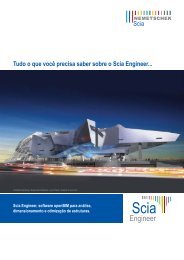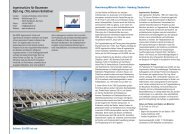VSH Turòa nad Bodvou - Nemetschek Scia
VSH Turòa nad Bodvou - Nemetschek Scia
VSH Turòa nad Bodvou - Nemetschek Scia
You also want an ePaper? Increase the reach of your titles
YUMPU automatically turns print PDFs into web optimized ePapers that Google loves.
Introduction<br />
The various judicial services of Antwerp urgently needed new law<br />
courts, as they were suffering from an acute lack of space and being<br />
scattered all over the city. At the request of VK, Richard Rogers and<br />
Arup signed up for the public competition for new law courts on<br />
the Bolivar place, organized by the Buildings Agency.<br />
The project of the temporary association RRP - VK - Arup is a<br />
gateway for Antwerp, entering or leaving the city from the south. It<br />
stands on a prominent place, at the end of the “leien” (main streets<br />
of Antwerp), on a location where Antwerp always has had a focal<br />
point, that is ‘The Spanish Citadel (from 1571 until 1894) and the<br />
South Station (“the cathedral of the South”) until 1966.<br />
Furthermore, the law courts project was seen as part of a revitalization<br />
process of the south of Antwerp.<br />
Description<br />
The new law courts are designed as an open house. Large glass<br />
surfaces connect the judicial services with the citizens of Antwerp<br />
and offer marvellous sights on the city. This not only enhances the<br />
transparency, literally and figuratively, but it also insures a good<br />
system of finding one’s way.<br />
Sustainability was another key word. The Buildings Agency stipulated<br />
that they wanted a building that didn’t need mechanical<br />
cooling in the offices. As such, the law courts make an architectural<br />
as well as an environmental statement<br />
The construction counts 6 office wings, placed around a central<br />
public space, the ‘Salle des Pas Perdus’ (Hall of Lost Paces).<br />
From the Bolivar place, a monumental staircase mounts up to this<br />
imposing but light reception space, which acts as an extension of<br />
the public square. From the hall, 6 office wings stretch out (3 on<br />
the left and 3 on the right hand side) and are connected on the<br />
2nd floor through walking galleries. The more public functions are<br />
situated directly near the hall; the parts that are more inaccessible<br />
for the public are situated further down the wings.<br />
In between the office wings, inner yards were laid out, offering a<br />
green sight for the office workers and cooling down the warm air<br />
that flows between the office wings.<br />
With 1 level underground (cells and parking) and 5 levels above<br />
ground, the building measures not higher than 15,75 metres.<br />
The complex circulation-system of law courts, in order to protect<br />
privacy and for security reasons, demands that private and public<br />
circulation are clearly separated. Therefore, the project team<br />
decided to put the actual courts (26 smaller courts and 6 larger<br />
courts) on top of the building, above the offices of judges, administration,<br />
…<br />
In this configuration, the courts almost float above the building<br />
and are crowned with striking cone-shaped roofs. The roofs on the<br />
large courts peak at 41 metres above ground.<br />
Technical data<br />
Public tender organization: Buildings Agency<br />
End user: Federal government service of Justice<br />
Architecture: Richard Rogers Partnership - VK STUDIO - Arup<br />
Duration of the works: April 2001 to October 2005<br />
Surface terrain: 3,7 ha<br />
Gross surface: 78.000 m²<br />
Facade height: 18 metres<br />
Facade width front: 300 metres<br />
Facade width back: 240 metres<br />
Roofs on courts<br />
Start placement roofs: July 2003<br />
End placement roofs: mid 2004<br />
Height large roof: 25 metres (41 metres above ground)<br />
Height small roof: 7 metres (18 metres above ground)<br />
Weight large roof 24 tons<br />
Weight small roof: 18 tons<br />
Gauge inox coating: 0,4 mm<br />
Surface inox coating: 16.000 m²<br />
Roof structure public hall<br />
Start placement steel structure: March 2004<br />
End placement steel structure: June 2004<br />
Measurements: 60 metres x 70 metres<br />
Weight steel construction: 240 tons<br />
Painted surface steel structure: 2.400 m²<br />
Importance, approach and results<br />
Roofs of the law courts<br />
The pointed roofs are without a doubt the most striking characteristic<br />
of the law courts. The applied structural concept, material and<br />
construction method resulted from a thorough analysis, considering<br />
all pros and cons of the various options. Through wind tunnel<br />
tests, the most unfavourable wind charges were determined and<br />
wind disturbance on the surroundings analysed.<br />
The results of the tests, combined with other forces (influenced by<br />
temperature, snow and finishing materials), gave the necessary<br />
data to be able to calculate all structures three-dimensionally.<br />
Also, the calculated distortions of the structures had to be checked<br />
with the compliance of the finishing materials.<br />
At the end, the project team opted for a hyperbolic paraboloid or<br />
hyparscale. This figure has a great advantage: it can be constructed<br />
from linear elements, allowing for a simple method of covering and<br />
coating it.<br />
One roof is composed from 4 connected quadrants (2 high and 2<br />
low quadrants), each a hyparscale in a square base.<br />
The linear elements, as a filling-in of the quadrants, are executed<br />
in a “woven” wood-structure, using planks screwed on top of one<br />
another and fixing them on a centring. This allows for the coating<br />
to follow the curved form perfectly.<br />
Roofs Courthouse Antwerp<br />
The wood-structure is left visible on the inside, for the public to<br />
view the forces within the structure.<br />
During the conception phase, all possible finishing materials were<br />
considered. The hyperbolic paraboloid form of the roofs, specific<br />
connecting details, maintenance demands and sustainability and<br />
the transition from horizontal to slanting planes decided in favour<br />
of inox. Folded stainless strip steel was welded together by means<br />
of a continuous weld.<br />
The quadrant-construction-method made it possible for the roofs<br />
to be constructed completely off-site. After their transport on the<br />
river Scheldt, the segments were connected and mounted in a<br />
minimum of time and without scaffolds.<br />
The pointed roofs act as membranes, all charges are transferred to<br />
the underlying structures through normal forces.<br />
Roof of the central public hall<br />
The roof is a complex spatial structure, composed of triangle<br />
sections. Several junctions and points of support, situated at several<br />
levels in the space, hold the entire roof together.<br />
Eight of these points of support are spatially fixed: they are situated<br />
at the ground level of the central hall, in between the office wings.<br />
Six other junctions are situated at the concrete platforms of the<br />
large courts and are floating. This means the roof structure can’t<br />
be used to transfer the gravitational forces of the six high pointed<br />
roofs of the large courts.<br />
The roof structure is a grid of linear and spatial metal bars,<br />
connected through hinging joints. The pressure of the roof is<br />
resting on the top girders, which are connected with vertical rod<br />
resistors to subtending cables and bars.<br />
Horizontally, the roof offers support for the façade at the front and<br />
the back, but vertically the roof is completely unattached. In other<br />
words, the roof rests only on the 14 points of support mentioned<br />
above, not on the facades.<br />
Footbridges without intermediate support and as wide as the<br />
central hall hang underneath the roof construction. They connect<br />
the office wings on both sides of the hall.<br />
As well as the charges of its own weight, the roof is covered with<br />
doubled-glazed frames and sandwich boards. The glazing is doubly<br />
isolated, in order to prevent condensation.<br />
The most important external charges are snow and wind. In order<br />
to withstand these influences, wind tunnel tests were applied.<br />
A CFD simulation tested the roof structure in case of fire. The results<br />
showed that the temperature of the steel construction would not<br />
rise above 140°C in case of a standard fire, making it unnecessary<br />
to provide the structure with a fire resisting paint.<br />
197




